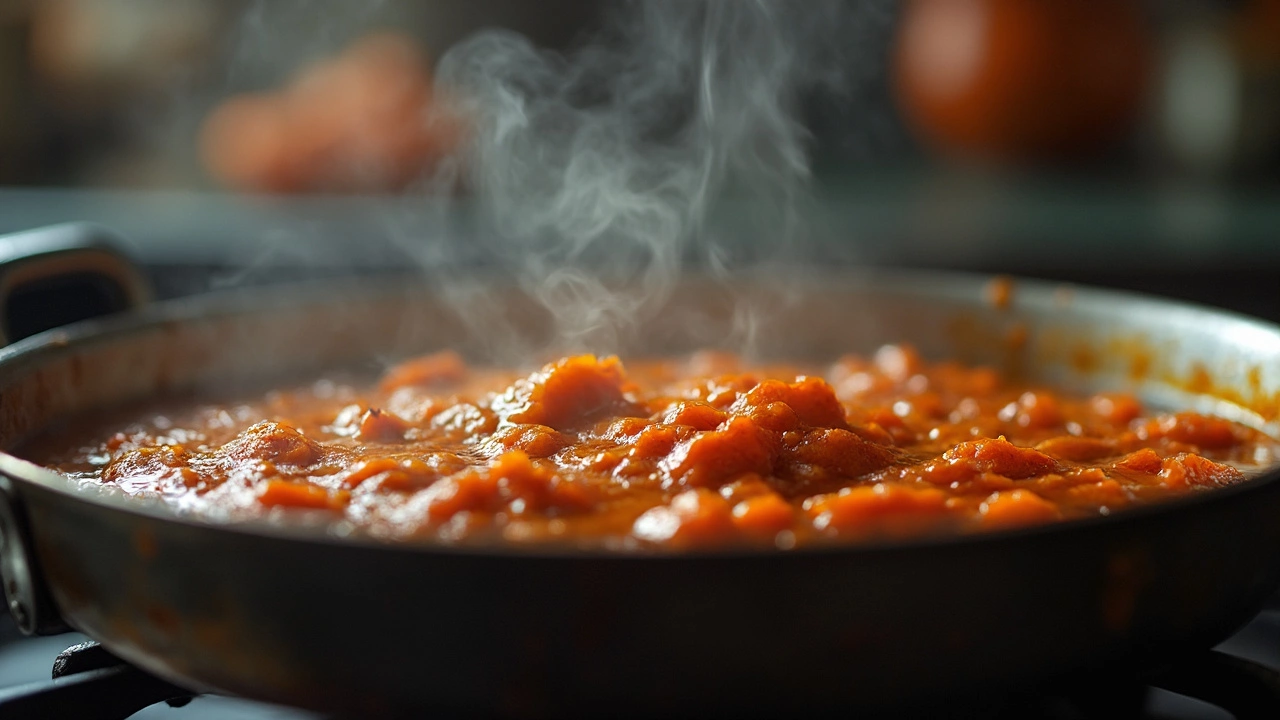Chutney Cooking: Lid On or Off?
 Mar, 24 2025
Mar, 24 2025
Ah, the age-old question of cooking chutney: lid on or lid off? If you're standing in your kitchen pondering this very dilemma, you're in the right place. Let's break it down.
The decision to use a lid or not when cooking chutney isn't just a matter of following recipes—it's about understanding the role of evaporation and consistency. Leaving the lid off lets moisture escape, which thickens the chutney as it cooks. This is perfect if you're looking for something that's less soupy and more robust. On the other hand, cooking with the lid on helps keep the moisture in, which might be exactly what you want if you prefer a looser texture.
But there's more to it than just texture. The lid also plays a part in preserving or releasing aromas. A closed lid traps those delicious smells, infusing the chutney with intensified flavors. So, if you're going for a deep, rich taste, you might want to lean towards the lid-on method. It's all about leveraging these techniques to achieve the chutney you love the most.
- The Role of the Lid
- Evaporation and Consistency
- Flavor and Aromatics
- Practical Tips for Perfect Chutney
The Role of the Lid
When it comes to chutney cooking, deciding whether to keep the lid on or off can feel like split-second guesswork. So, what's the science behind it? Let's break it down.
Evaporation and Chutney Consistency
The lid affects how much moisture is retained or evaporated during the cooking process. With the lid off, steam escapes, allowing the chutney to reduce more, thickening as it cooks down. This is great if you're aiming for a solid, spreadable chutney consistency.
On the flip side, using a lid traps steam inside, retaining more moisture and keeping the chutney's texture relatively wetter. This can be desirable if you're looking to pour it over dishes or prefer a runnier result. It's like adjusting your texture, based on how you like to experience your food.
Aromas: Strengthening Flavor Profiles
The lid plays a sneaky role in weaving aroma into your chutney recipes. Cooking with the lid on means you're essentially creating a flavor capsule, where those beautiful spices and ingredients mix and mingle intensively. The result? A taste that's nothing short of explosive. On the contrary, leaving the lid off allows some aroma to escape, offering a subtler end product.
Want a chutney that packs a punch? Try cooking your batch with the lid on for a portion of the time and then remove it towards the end to thicken it.
Practical Tips for Lid Usage
- Start with the lid off to ensure ingredients are melding as they should.
- Switch to lid on halfway through for aroma enhancement.
- Balance is key—adjust based on whether your chutney is too thick or thin.
Striking a balance between these two methods can elevate your chutney to new heights. It's about experimenting and finding the sweet spot that suits your taste buds.
Evaporation and Consistency
So, why does evaporation matter so much when you're cooking chutney? It's all about getting that perfect thickness and texture that makes your taste buds dance. When you cook with the lid off, you're letting steam escape, which helps reduce moisture. This reduction concentrates the ingredients and thickens the chutney naturally. It's like magic, but it's really just science at work!
However, finding the right balance is key. If you let too much moisture escape, you might end up with something more like a paste than a chutney. To avoid this, keep an eye on it. Stir occasionally and taste as you go along. You'll notice the flavors intensifying as the water evaporates.
Managing Chutney Texture
If it's getting thicker than you'd like, you can introduce a splash of water, vinegar, or even fruit juice to thin it out while adding a new layer of flavor. The key is to adjust gradually, tasting along the way to ensure you achieve the desired balance.
Chutney Science: Moisture Chart
Here's a quick cheat sheet to help you gauge moisture levels:
| Consistency | Chutney State |
|---|---|
| Watery | Needs more evaporation |
| Runny | Almost there |
| Thickened | Perfect consistency |
In short, the secret to a well-balanced chutney lies in controlling evaporation. Leaving the lid off can help you achieve that thick, luscious texture we all crave. But remember, it's not a set-it-and-forget-it affair. Keep stirring, tasting, and adjusting until it feels just right!

Flavor and Aromatics
When it comes to chutney cooking, balancing flavor and aromatics can be a game-changer. Why? Because the way aromas build up inside the pot can make a world of difference to the outcome of your dish. You see, cooking chutney isn't just about mixing a bunch of ingredients together; it's about coaxing the best out of each component.
The Science of Aroma
Did you know that cooking with the lid on helps trap steam, which in turn preserves volatile compounds responsible for those enticing aromas? These compounds can add layers of complexity to your chutney. If you're looking to highlight a specific spice or fruit, keeping the lid on can help intensify its scent and flavor.
On the flip side, cooking with the lid off can encourage quick evaporation of some of these volatile oils. This technique is awesome if you're aiming for a balanced chutney where no single aroma dominates. Want to impress with a nuanced blend? Go lid-off and allow the smells to escape, letting your senses guide you.
Impact on Ingredients
Different ingredients react in distinct ways during cooking, especially when it comes to their aromatic profiles.
- Spices: If you're using whole spices like cumin or mustard seeds, toasting them with the lid off can help them release their oils faster, which enhances flavor even before any other ingredients are added.
- Fruits: Cooking fruits like mangoes or tomatoes with the lid on can keep their syrupy essence concentrated, which might be exactly what you're gunning for if you're after a rich, fruity chutney.
Practical Tips
So, how do you decide? Here's a quick list of tips to get the best of both worlds:
- Start by toasting spices with the lid off to unlock their full flavor.
- Add the main ingredients with the lid on for the first half of cooking to intensify smells.
- Finish off the cooking with the lid off to reach your desired thickness and flavor concentration.
In the end, experimenting with lid positions during your chutney recipes will help you discover what works best for you. So go on, play around with the lid, and unlock a new dimension of aroma and taste.
Practical Tips for Perfect Chutney
Whether you're a newbie or a seasoned cook, there's always room to perfect your chutney cooking game. Here's a handy guide to ensure your chutney turns out just the way you like it.
1. Choosing Ingredients Carefully
The flavor of your chutney is only as good as its ingredients. Fresh produce means vibrant flavors, so always opt for fresh veggies and fruits, especially when making fruit-based chutneys.
2. Balancing Flavors
Chutneys are all about balance. Too sweet, too spicy, or too tangy can throw off the whole dish. A general rule of thumb is to taste as you go. Don't dump in all the sugar or vinegar at once—add little by little!
3. Consistency Control
Consistency is key, and this is where the lid debate comes into play. Start with the lid off to let the moisture escape and thicken your chutney. If you notice it getting too thick, cover it for a while.
4. Timing is Everything
Cooking time also plays a crucial role in flavor development. Too short and the flavors won’t meld; too long and you might end up with a jam. Most chutneys benefit from a slow simmer until slightly thick, about 30 to 45 minutes.
5. Storing and Serving
Chutneys often taste better after sitting in the fridge for a day, letting the flavors meld. Store in an airtight jar, and it'll last for weeks. Remember to bring it to room temperature before serving for the best taste.
These tips should put you well on your way to crafting perfect chutneys every time. And hey, experiment a bit—after all, the best recipes often come from a bit of creativity!
